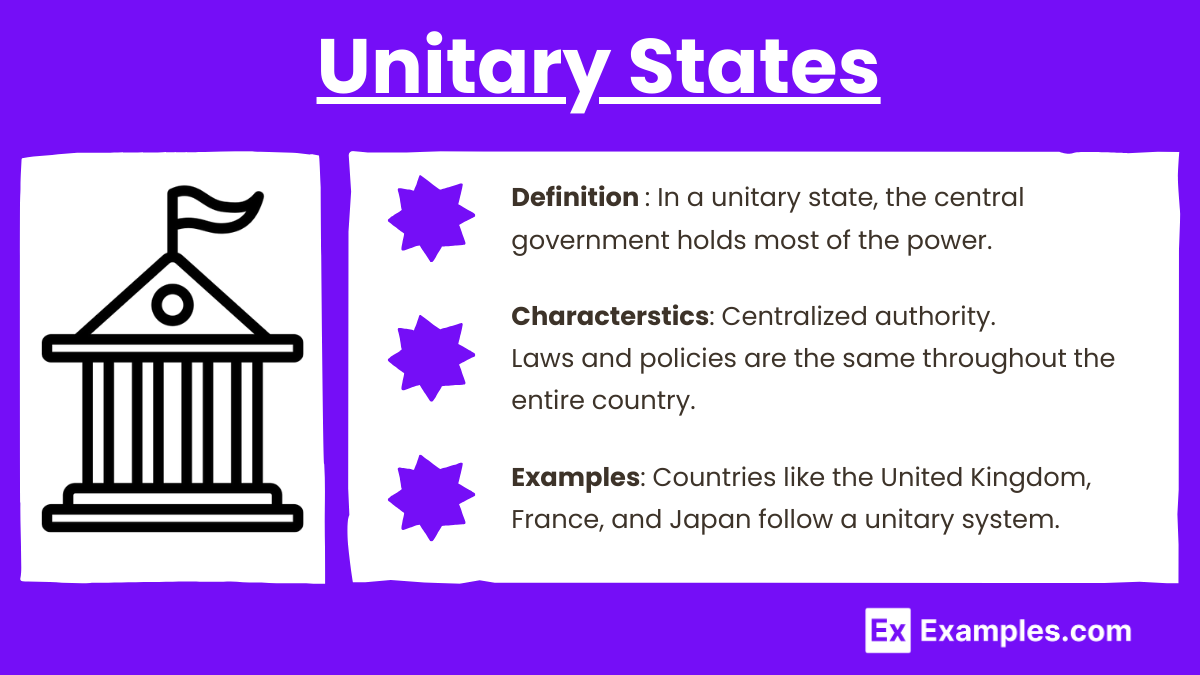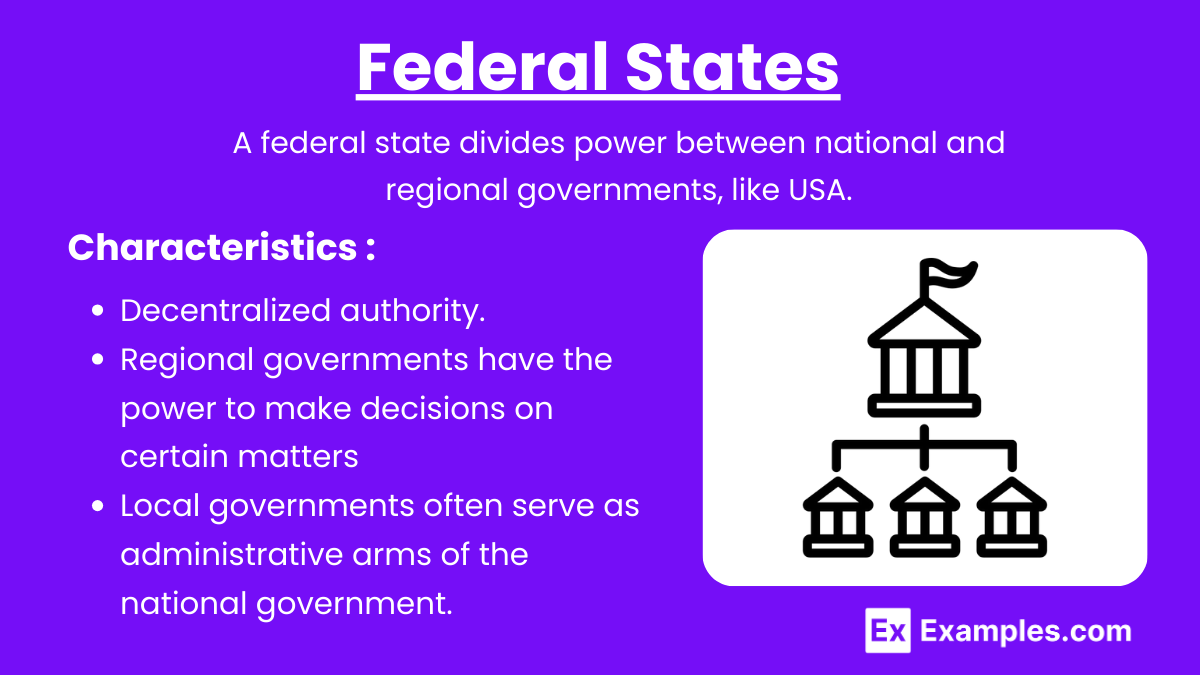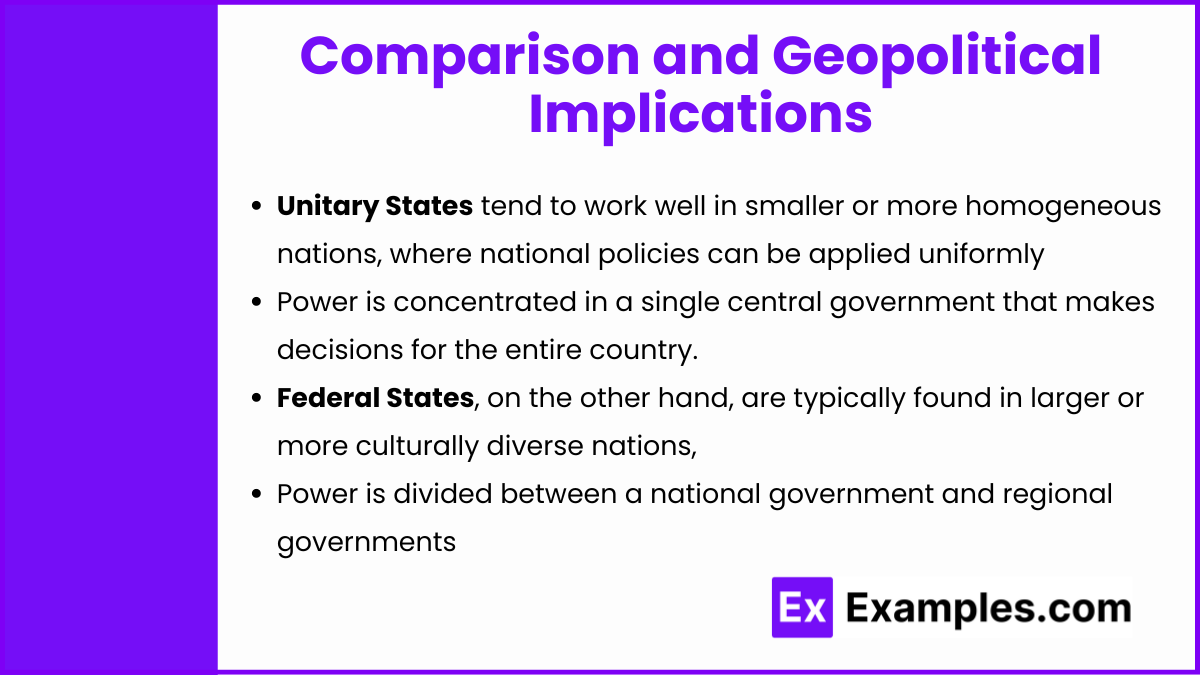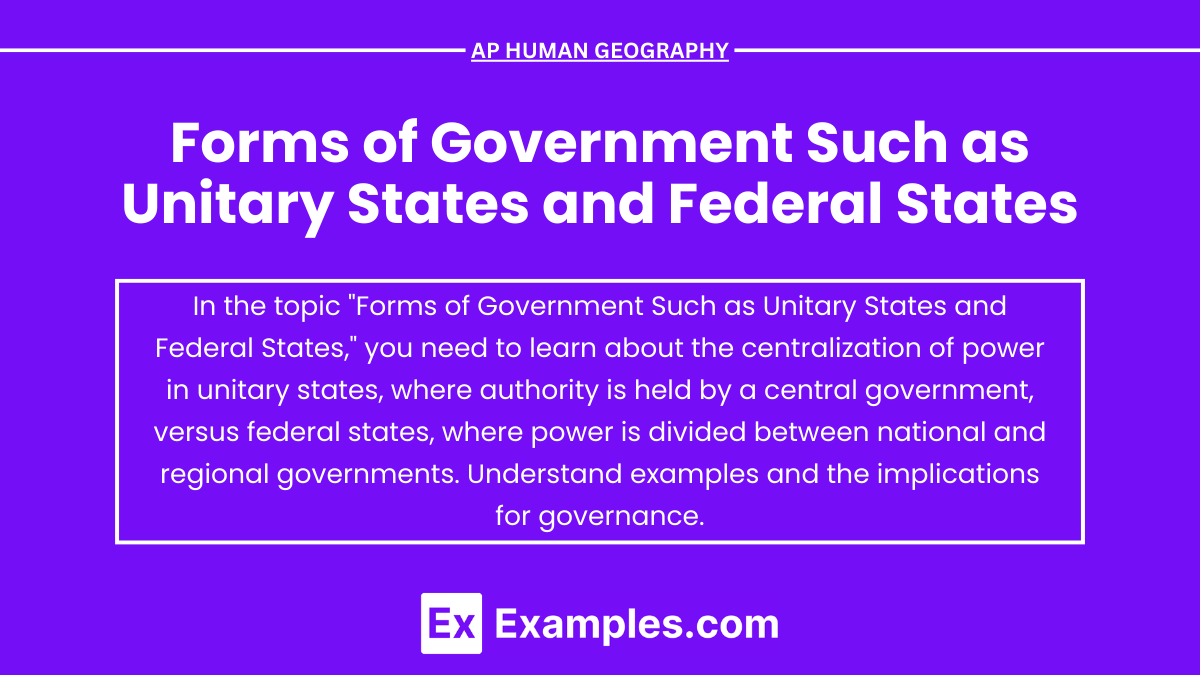In AP Human Geography, understanding forms of government like unitary states and federal states is essential for analyzing how political power is organized across space. A unitary state centralizes authority, with the national government holding most of the power and local regions following its directives. In contrast, a federal state divides power between national and regional governments, allowing for local autonomy and representation. These governmental structures influence political decision-making, resource distribution, and the relationship between national and local entities across diverse geographic regions.
Free AP Human Geography Practice Test
Learning Objectives
When studying the topic of "Forms of Government Such as Unitary States and Federal States" for AP Human Geography, you should focus on understanding how power is distributed between national and regional governments in both unitary and federal systems. Learn the characteristics, advantages, and disadvantages of each form, and explore how they affect governance, regional autonomy, and political stability. Additionally, analyze real-world examples and consider the geopolitical and social implications of these systems on national and regional development.
Forms of Government: Unitary States and Federal States
In the context of political geography, governments can be classified into unitary states and federal states, based on how power and authority are distributed between the national and regional levels.
Unitary States

Definition: In a unitary state, the central government holds most of the power, and any administrative divisions (such as provinces or regions) exist primarily to implement national policies. Local governments, if they exist, have little autonomy and act under the authority of the central government.
Characteristics:
Centralized authority.
Laws and policies are uniform across the entire country.
Local governments often serve as administrative arms of the national government.
Decision-making is typically streamlined because of the concentration of power.
Examples: Countries like the United Kingdom, France, and Japan follow a unitary system.
Advantages: Efficient decision-making, uniform policies, and reduced conflict between national and regional authorities.
Disadvantages: It may neglect local needs and concerns, and regions with distinct identities may feel underrepresented or marginalized.
Federal States

Definition: In a federal state, power is divided between the national government and regional governments (such as states or provinces). Both levels of government have specific powers, often defined by a constitution, and act relatively independently in their domains.
Characteristics:
Decentralized authority.
Regional governments have the power to make decisions on certain matters without interference from the central government.
There is often a written constitution that outlines the division of powers.
Greater representation of diverse groups and local interests.
Examples: The United States, Canada, and Germany are examples of federal states.
Advantages: Encourages representation of local interests, fosters innovation at the regional level, and prevents over-centralization of power.
Disadvantages: It can lead to inconsistencies in laws and policies across regions, and conflicts between national and regional governments are more likely.
Comparison and Geopolitical Implications

Unitary States tend to work well in smaller or more homogeneous nations, where national policies can be applied uniformly without causing significant discontent.
Power is concentrated in a single central government that makes decisions for the entire country. The central government can enact decisions quickly without needing approval from regional bodies, making it easier to implement nationwide reforms.v
Federal States, on the other hand, are typically found in larger or more culturally diverse nations, where local autonomy helps maintain stability and address regional needs more effectively.
Power is divided between a national government and regional governments, with each having its own authority in specific areas. Federal systems often require negotiations between the national and regional governments, which can be time-consuming but helps accommodate diverse populations.
Examples
Example 1: United Kingdom (Unitary State)
The UK operates under a unitary form of government where political power is centralized in the Parliament located in London. While Scotland, Wales, and Northern Ireland have devolved powers, the ultimate authority remains with the central government. This structure allows for uniform policies across the nation but may cause tension with regional groups seeking more autonomy.
Example 2: France (Unitary State)
France is another example of a unitary state with a strong centralized government. The regions and departments in France have administrative roles but limited decision-making power, as most authority resides in Paris. The unitary structure has historically been effective in maintaining national cohesion and implementing widespread policies uniformly.
Example 3: United States (Federal State)
The U.S. is a classic example of a federal state, where power is constitutionally divided between the federal government and individual states. Each state has its own government with authority over local matters such as education and transportation. This division of power allows for regional diversity in governance while ensuring national policies are maintained across the country.
Example 4: Germany (Federal State)
Germany has a federal system where power is shared between the central government and 16 individual states known as Länder. Each state has its own constitution, government, and responsibilities in areas like education, law enforcement, and infrastructure, while the national government handles foreign policy and defense. This system reflects the country's cultural and historical diversity, allowing local autonomy within a unified nation.
Example 5: Japan (Unitary State)
Japan follows a unitary form of government with strong central control emanating from Tokyo. Regional and local governments exist, but they function under the policies established by the central government. This centralized system is effective in maintaining uniformity and control across Japan’s islands, ensuring consistent development and governance.
Multiple Choice Questions
Question 1
Which of the following best describes a unitary state?
A. Power is divided between national and regional governments, each having their own specific authority.
B. Local governments have significant autonomy in making laws and policies.
C. The central government holds most of the power, with limited authority granted to local governments.
D. There is no central government; each region governs itself independently.
Answer: C
Explanation: A unitary state is characterized by centralized power, where the national government holds the majority of authority. Local governments, if they exist, have limited power and mainly function as administrative units under the direction of the central government. Examples include countries like France and Japan. This contrasts with federal states, where power is divided between central and regional governments.
Question 2
Which of the following countries is an example of a federal state?
A. Japan
B. France
C. United States
D. United Kingdom
Answer: C
Explanation: The United States is a federal state, where power is divided between the national (federal) government and individual state governments. Each level of government has its own specific authorities, such as education policies or taxation, allowing states to make laws independently of the national government on certain issues. Japan and France, on the other hand, are unitary states, while the United Kingdom operates as a unitary state with devolved powers to regions like Scotland and Wales.
Question 3
Which of the following is a potential disadvantage of a federal system of government?
A. It leads to uniform policies and decision-making across the entire country.
B. It provides less representation for diverse local interests.
C. It may result in inconsistent laws and policies across different regions.
D. It centralizes power, reducing regional autonomy.
Answer: C
Explanation: A disadvantage of federal systems is that different regions (states or provinces) may pass laws that vary significantly from one another, leading to inconsistencies across the country. For example, in the United States, some states may have different regulations on healthcare, education, or even civil rights, which can create confusion or inequality across the nation. Option A refers to unitary states, while option D also describes unitary systems.


